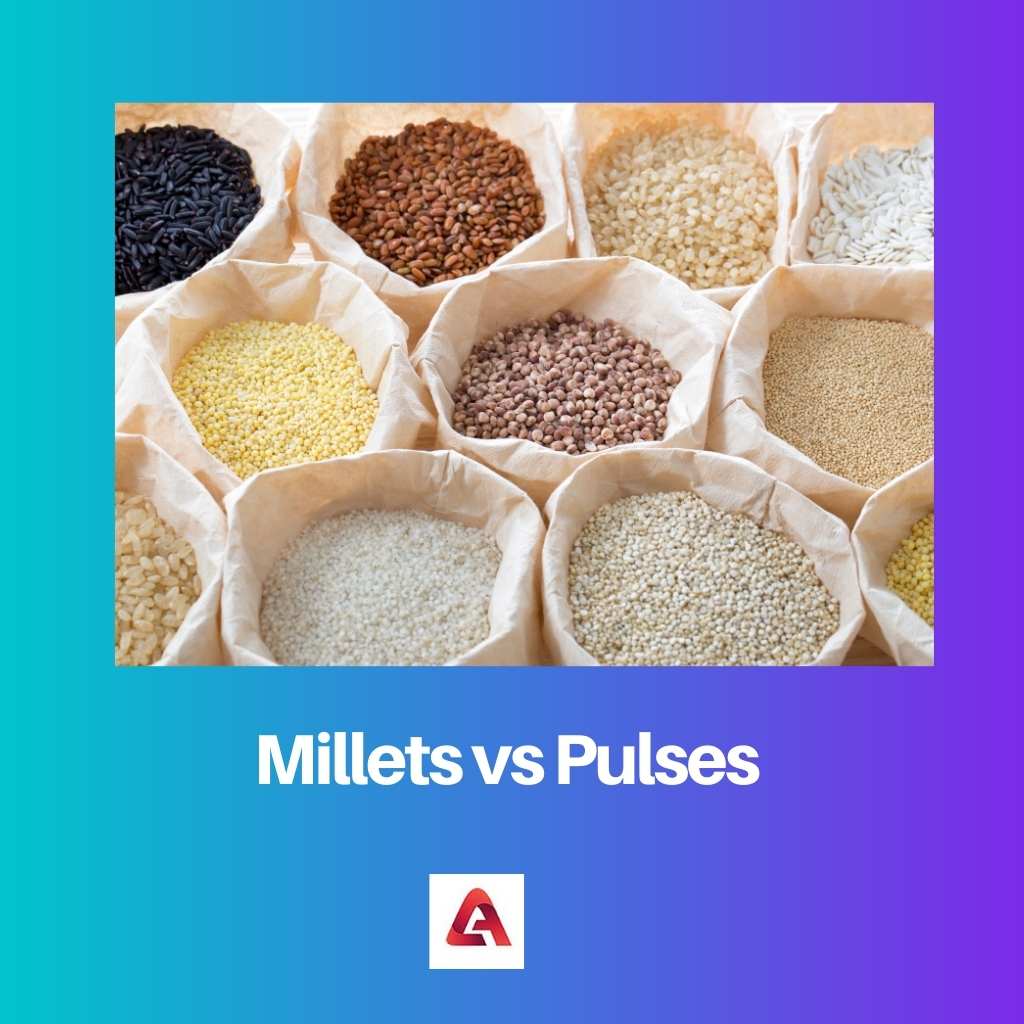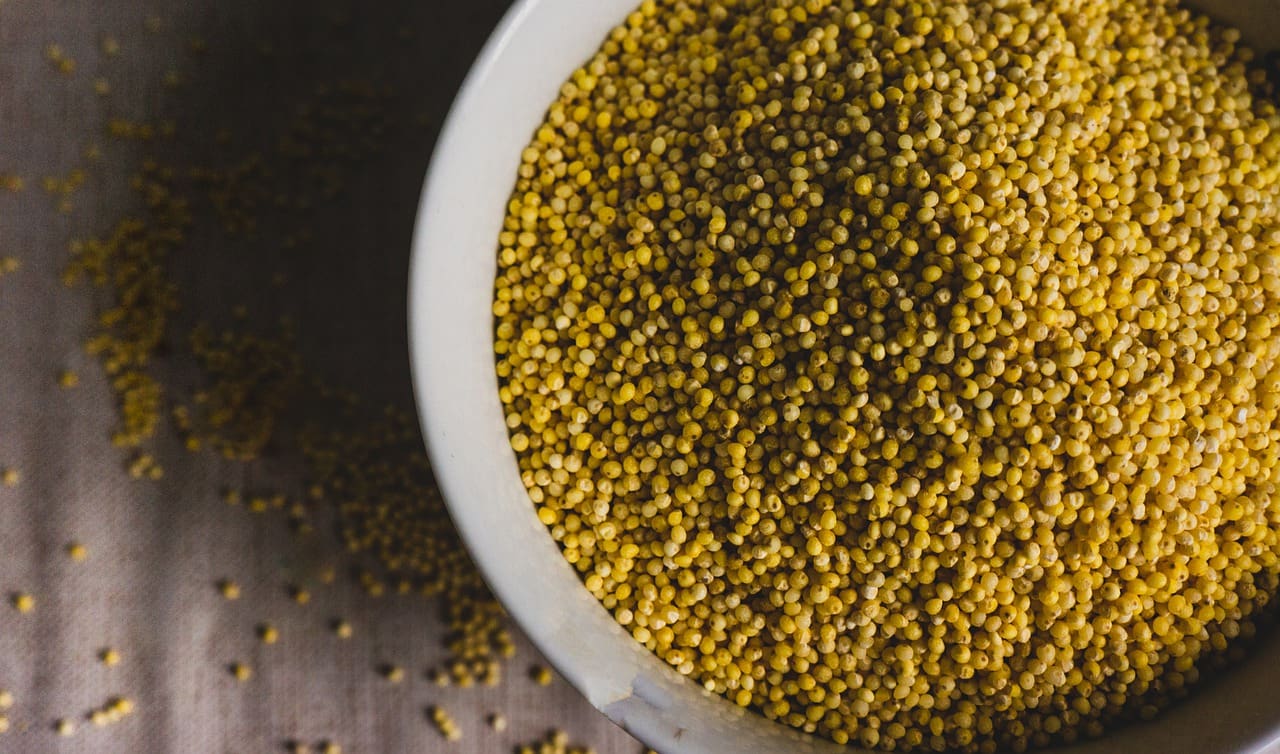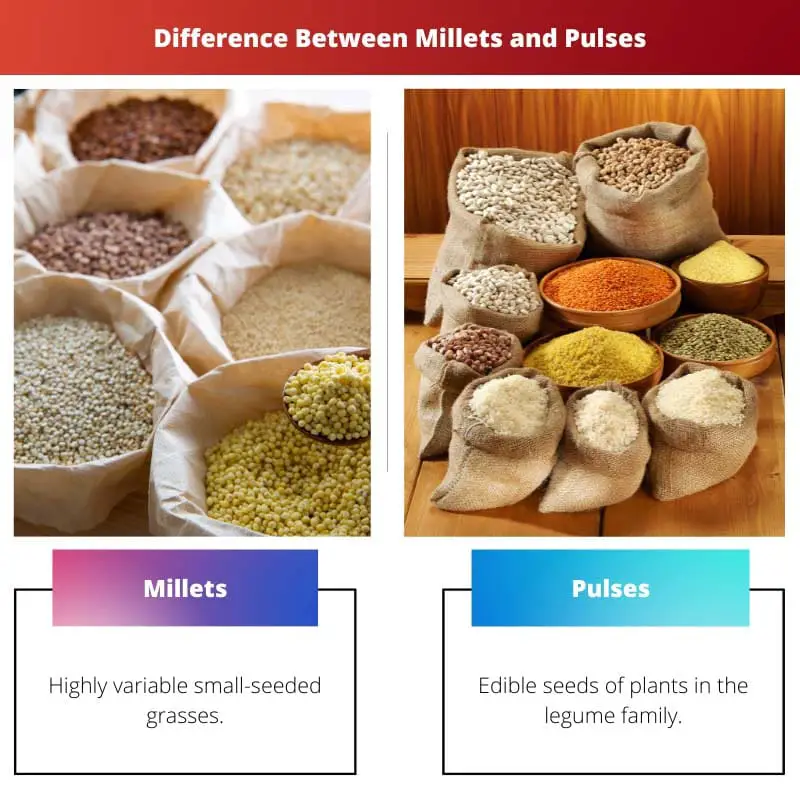To survive and stay healthy, humans require a variety of minerals and nutrients. The grains known as millets and pulses are two key suppliers of minerals and nutrients.
They are grown for human and animal consumption all over the world. Whole grains, oilseeds, pseudocereals, and other foods with significant health advantages are included.
People eat plant components that are considered edible. Specific plants’ seeds, fruit, stems, flowers, and roots are consumed.
Grains are plant seeds that are eaten as food. Farmers cultivate grain-producing plants and sell the grains they produce.
Grains include rice, wheat, pulses, barley, and millet.
Key Takeaways
- Millets are a type of cereal grain that is gluten-free and rich in nutrients, while pulses are legumes high in protein and fiber.
- Millets are mainly used for making flour, while pulses are consumed as a whole or as dal or lentils.
- Millets are grown in various regions of the world, while pulses are widely cultivated in India, Canada, and the United States.
Millets vs Pulses
Millets are small-seeded grasses that are grown for their edible seeds. They are used as a substitute for rice or wheat in many parts of the world. Pulses are leguminous crops which are grown for their edible seeds. They are a good source of protein and are commonly used in vegetarian diets.

Millets are little, edible seeds that are grown in arid conditions. Millets belong to the Paniceae tribe of the Panicoideae subfamily, and some of the most common Millet crops include Foxtail, Pearl, Finger, and Proso Millet.
Millets are mostly grown in Asia and Africa since they require dry weather to grow.
Pulses are grain legumes, which are dry seeds. Dry peas, dry beans, lentils, and chickpeas are among the 12 crops in this family.
Even though pulses are grown in smaller quantities than cereals, they are high in protein, fiber, amino acids, iron, and vitamins. With the help of parasitic microbes on their roots, leguminous plants may take nitrogen from the air.
Comparison Table
| Parameters of Comparison | Millets | Pulses |
|---|---|---|
| What is it | Highly variable small-seeded grasses | Edible seeds of plants in the legume family |
| Grows in | Nigeria, India, Mali, and Niger | India, China, Nigeria, Brazil, Tanzania, Russia, USA, Australia, Canada, and Myanmar. |
| Calories | 207 | 335 |
| Main Nutrients | Phosphorus, potassium, calcium, Vitamins B and K. | Iron, zinc, magnesium, and fiber. |
| Types | Sorghum millet, amaranth millet, proso millet, foxtail millet, little millet, etc. | Lentils, cowpeas, chickpeas, dry beans, kidney beans, pigeon beans, lupins, etc. |
What are Millets?
Millets are a type of cereal that is grown in the United States. They are cultivated for their small, edible seeds, which are utilized as both human food and animal fodder.
Millet crops are grown in semi-arid tropics with minimal rainfall requirements. Millets are primarily grown in Asia and Africa due to the climate conditions.
Millet farming was first documented in the Korean Peninsula about 3500-2000 BC.
Millet crops grew popular in the Asian subcontinent after that due to their drought resistance, capacity to thrive in less rich soils, minimal water requirements, and inexpensive cost of production.
Asian millet types were introduced to Europe until 5000 BC, most likely by the Chinese via the Black Sea.
Millet crops are high in potassium, phosphorus, magnesium, fat, and carbohydrates, among other nutrients. Millets are very easy to digest, making them beneficial to the stomach.
Millets have played an important part in agriculture and farming for over 7,000 years.
Millets are fed to animals to replace all of the nutrients they are missing in their daily diet. Millets are a wonderful way to manage blood sugar levels and, because of their high fiber content, are also ideal for slowing digestion.
Millet also has a high level of vitamin B and vitamin K, among other nutrients. Millet is high in several essential elements, including iron and manganese, in addition to these vitamins.
Millet is used to producing fermented beverages like rakshi. Millet flour is used along with sorghum flour to produce flatbread in India. Finger millet known as Raghi is used to make soups and fed to children in South India.

What are Pulses?
Pulses are dry grains that belong to the Plantae kingdom’s Leguminosae family. Annual Legumes are a type of pulse that is high in protein and amino acids.
Amino acids, protein, fiber, vitamins, lipids, and other minerals abound in pulses. They have a reduced carbohydrate content.
However, there are certain exceptions that are high in carbohydrates. Potassium, zinc, iron, magnesium, phosphorus, and other minerals are abundant in pulses.
Pulses need less moisture to survive. Hence, they survive easily, even in dry environments. Some types thrive in the warm climate of summers and are known to be summer-adaptable, whereas others grow in the cold season.
Pulses are produced and consumed in large quantities in India.
Pulses, which comprise seeds such as lima beans, butter beans, kidney beans, and broad beans, are consumed in greater quantities than we know.
As previously said, they are high in protein and nutrients, making them a good source of protein in diets where other protein sources such as meat and dairy products are scarce.
Pulses are high in fiber and low in fat, and they help manage blood sugar and cholesterol. As a result, they also support the fight against obesity.
Pulses are advised by dieticians and health organizations for the maintenance of diseases such as diabetes and heart-related disorders due to their properties.

Main Differences Between Millets and Pulses
- Millets are highly variable small-seeded grasses, whereas pulses are the edible seed of the plants from the legume family.
- Millets are classified into the Plantae kingdom, the Poales order, and the Poaceae family. Pulses are classified into the plant kingdom, the fables order, and the Leguminosae family.
- Millets are primarily grown in Asia and Africa, and pulses are primarily grown in India, Nigeria, Brazil, the USA, etc.
- Millets have 207 calories, and pulses have 335 calories.
- Millets have a surplus of vitamin B and K, Calcium, etc., and pulses have a surplus of iron, magnesium, zinc, etc.
- The types of millets can include Proso millet, foxtail millet, little millet, etc. The types of pulses can include chickpeas, dry beans, kidney beans, etc.

